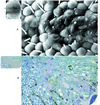A Drosophila PIAS homologue negatively regulates stat92E
- PMID: 11504941
- PMCID: PMC55492
- DOI: 10.1073/pnas.171302098
A Drosophila PIAS homologue negatively regulates stat92E
Erratum in
- Proc Natl Acad Sci U S A 2001 Nov 20;98(24):14186
Abstract
Transcriptional activation by, and therefore the physiologic impact of, activated tyrosine-phosphorylated STATs (signal transducers and activators of transcription) may be negatively regulated by proteins termed PIAS (protein inhibitors of activated stats), as shown by previous experiments with mammalian cells in culture. Here, by using the genetic modifications in Drosophila, we demonstrate the in vivo functional interaction of the Drosophila homologues stat92E and a Drosophila PIAS gene (dpias). To this end we use a LOF allele and conditionally overexpressed dpias in JAK-STAT pathway mutant backgrounds. We conclude that the correct dpias/stat92E ratio is crucial for blood cell and eye development.
Figures




References
-
- Darnell J E., Jr Science. 1997;277:1630–1635. - PubMed
-
- Stark G R, Kerr I M, Williams B R, Silverman R H, Schreiber R D. Annu Rev Biochem. 1998;67:227–264. - PubMed
-
- Starr R, Willson T A, Viney E M, Murray L J L, Rayner J R, Jenkins B J, Gonda T J, Alexander W S, Metcalf D, Nicola N A, Hilton D J. Nature (London) 1997;387:917–921. - PubMed
-
- Endo T A, Masuhara M, Yokouchi M, Suzuki R, Sakamoto H, Mitsui K, Matsumoto A, Tanimura S, Ohtsubo M, Misawa H, et al. Nature (London) 1997;387:921–924. - PubMed
-
- Naka T, Narazaki M, Hirata M, Matsumoto T, Minamoto S, Aono A, Nishimoto N, Kajita T, Taga T, Yoshizaki K, et al. Nature (London) 1997;387:924–929. - PubMed
Publication types
MeSH terms
Substances
Grants and funding
LinkOut - more resources
Full Text Sources
Molecular Biology Databases

